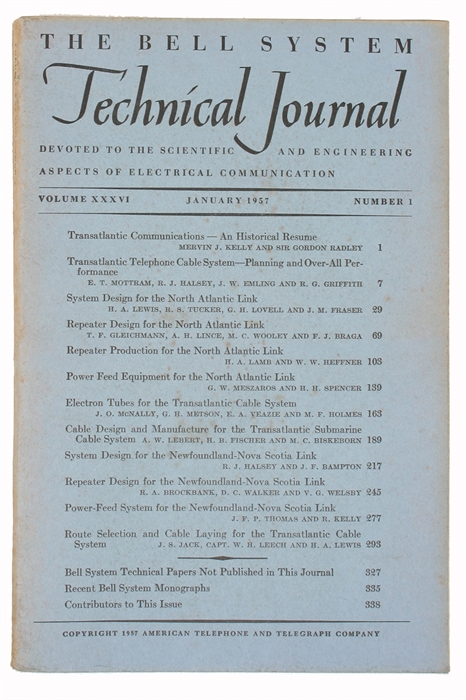FIRST DESCRIPTION OF THE FIRST SUBMARINE TRANSATLANTIC TELEPHONE CABLE SYSTEM, TAT-1
[VARIOUS AUTHORS].
Transatlantic Communications. [11 papers, see below].
New York, American Telephone and Telegraph Company, 1957. 8vo. Volume 36, 1957 of "The Bell System Technical Journal". In the original printed blue wrappers. Sunning to spine, and very minor spotting to wrappers. Internally near mint. 348 pp.
First edition of the first technical description of the TAT-1, the first submarine transatlantic telephone cable system. The 2,240-mile cable was laid by the cableship Monarch and ran from Gallanach Bay, near Oban in Argyll, to Clarenville, Canada.
"The papers that follow describe the design, manufacture and installation of the first transatlantic telephone cable system with all its component parts, including the connection microwave radio-relay system in Nova Scotia." (From the introduction to the present volume).
"Years of development led up to 1956 when the first transatlantic telephone cable system started carrying calls; this is an interesting story in itself. Two coaxial cables about 20 miles apart carried 36 two-way circuits. Nearly 50 sophisticated repeaters were spaced from 10 to 40 miles along the way. Each vacuum tube repeater contained 5,000 parts and cost almost $100,000." (Petruzzellis, Thomas. Telephone Projects for the Evil Genius, 2008, p. 4).
The electronic repeaters, the devices that held together the many separate cables, were designed by the Bell Telephone Laboratories. In terms of reliable operation, the most critical component of the system was the repeater. These devices, spaced at intervals of 37.5 nautical miles along the cable, compensated for loss. The repeaters were of a unique flexible design, which allowed them to be handled in the same manner as cable.
TAT-1 carried the Moscow-Washington hotline between the American and Soviet heads of state.
Other papers of interest contained in the present volume:
1. Kelly, Dr. Mervin J.; Radley, Sir Gordon. Transatlantic Communications - An Historical Resume. Pp. 1-5.
2. Mottram, E.T.; Halsey, R.J.; Emling, J.W.; Griffith, R.G. Transatlantic Telephone Cable System - Planning and Over-All Performance. Pp. 7-27.
3. Lewis, H.A.; Tucker, R.S.; Lovell, G.H.; Fraser, J. M. System Design for the North Atlantic Link. Pp. 29-68.
4. Gleichmann, T.F.; Lince, A.H.; Wooley, M.C.; Braga, F.J. Repeater Design for the North Atlantic Link. Pp. 69-101.
5. Lamb, H.A.; Heffner, W.W. Repeater Production for the North Atlantic Link. Pp. 103-138.
6. Meszaros, G.W.; Spencer, H.H. Power Feed Equipment for the North Atlantic Link. Pp. 139-162.
7. McNally, J.O.; Metson, G.H.; Veazie, E.A.; Holmes, M.F. Electron Tubes for the Transatlantic Cable System. Pp. 163-188.
8. Lebert, A.W.; Fischer, H.B.; Biskeborn, M.C. Cable Design and Manufacture for the Transatlantic Submarine Cable System. Pp. 189-216.
9. Halsey, R.J.; Bampton, J.F. System Design for the Newfoundland-Nova Scotia Link. Pp. 217-244.
10. Brockbank, R.A.; Walker, D.C.; Welsby, V.G. Repeater Design for the Newfoundland-Nova Scotia Link. Pp. 245-276.
11. Thomas, J.F.P.; Kelly, R. Power-Feed System for the Newfoundland-Nova Scotia Link. Pp. 277-292.
12. Jack, J.S.; Leech, Capt. W.H.; Lewis, H.A. Route Selection and Cable Laying for the Transatlantic Cable System. Pp. 293-326.
Order-nr.: 43339

